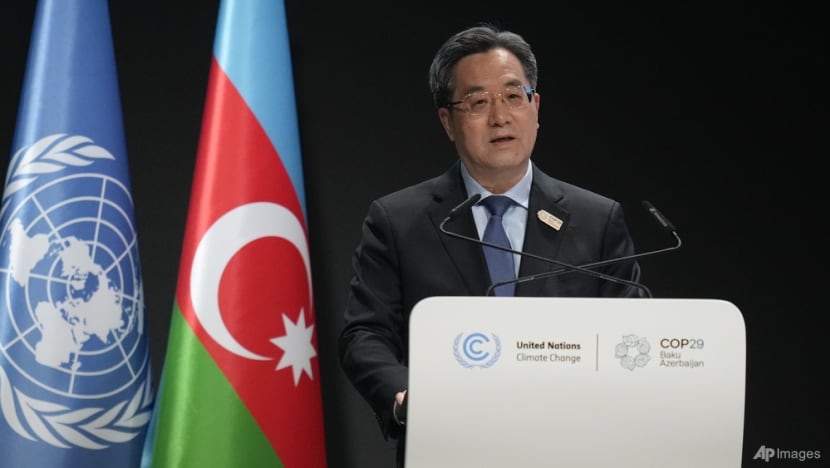Commentary: US will leave a void in climate leadership. Can China fill it?
Commentary: US will leave a void in climate leadership. Can China fill it?
China is determined to continue growing its influence on the world stage. And the United States, under incoming president Donald Trump, presents it with the opportunity to do just that – in climate action.
A long-time sceptic of climate change, Trump had already left a void to fill in his first term. In 2017, he withdrew the United States from the Paris Agreement, stating that he served the people "of Pittsburgh, not Paris". In response, China affirmed its commitment to the landmark climate agreement and called for continued global cooperation.
China has also embraced a notably progressive rhetorical stance. In 2017, China started to describe itself as a "participant, contributor and leader" in international environmental governance – the first time it described itself as a leader.
While the US may regress in its international climate action over the next four years, China cannot rest on its laurels if it truly aspires to become a global leader.
AFFORDABLE CLEAN ENERGY IN NEW MARKETS
China has far outpaced its competitors in producing low-carbon technologies, which positions it as a key player in helping developing countries speed up their clean energy transitions.
China controls a majority share of the global market for green technologies. Currently, it supplies more than 80 per cent of the world's solar manufacturing capacity and leads in wind turbines, batteries and electric vehicles.
Its rise in this field is supported by domestic economic policies that actively promote the "new three” industries – solar, electric vehicles and batteries – as drivers of economic development at a time when traditional economic drivers like real estate have become more unstable.
Though Europe and the US continue to place tariffs and restrictions on Chinese imports and worry about overcapacity, China and its affordable green technology will still look attractive to markets in developing countries.
Though these new markets offer opportunities, China must still court them as partners. It’s imperative to build up strong relationships to avoid criticisms of dumping renewable technologies, such as by demonstrating interest in investing in production hubs as it has in Southeast Asia. At the Forum on China-Africa Cooperation held in September, China committed to establishing 30 renewable energy projects, demonstrative of the reach China is trying to achieve.
MONEY TALKS
China can also play a bigger role in climate finance – the overarching theme at the COP29 climate conference in November.
In Baku, China played a key role in negotiations by encouraging parties to resolve disputes around the New Collective Quantified Goal (NCQG), a new climate finance goal that aims to bridge gaps in accessibility and prioritise developing countries' needs.
China reinforced the importance of multilateral frameworks and argued that developed countries should still take the lead in climate finance contributions on account of the principle of common but differentiated responsibility.
COP29 parties were able to agree on a new goal consisting of two parts: Increasing “core” financing from the original US$100 billion to at least US$300 billion annually by 2035, and an “additional layer” of up to US$1.3 trillion primarily encompassing private financing. While this was criticised by some developing countries for its lack of ambition, the NCQG outcome nevertheless reflected progress.
Importantly, the COP29 deal was achieved with China willing to count its south-south and multilateral development bank finance in towards the new finance goal. This represents a significant step forward.
China has also, for the first time, publicly announced its climate finance contributions. At COP29, Vice Premier Ding Xuexiang said that China has provided and mobilised 177 billion yuan (more than US$24 billion) in support of climate action in the Global South since 2016.

According to a report by the World Resources Institute, China voluntarily provided and mobilised US$45 billion from 2013 to 2022 to support efforts to curb emissions or adapt to climate impacts in developing countries, amounting to roughly 6 per cent of the total climate finance from developed countries during the same 10-year period.
As a developing country itself, China does not have a responsibility to provide climate finance but its voluntary contributions to other developing countries help it garner a reputation for being vested in advancing collective action.
One challenge involves being viewed as pursuing more “debt trap diplomacy”, the accusation of using unsustainable loans for strategic control that has dogged the Belt and Road Initiative. China must provide its climate finance contributions with intentionality and carefully offer finance that takes into account the vulnerability of developing nations.
DOES CHINA WALK THE WALK?
But can China credibly be seen as a global climate action leader if it is also the world’s largest carbon emitter? China will have to show that it walks the walk.
World coal use is set to hit a record high in 2024, according to the International Energy Agency on Dec 18. China accounts for more than half of global coal demand – due to increasing demand for electricity despite 44 per cent coming from renewable sources – and about half of global coal production.
China’s official target is to reach peak carbon emissions by 2030 and net zero by 2060, though some experts believe the peak could come as early as 2025 or 2026.
The next round of Nationally Determined Contributions (NDCs), or domestic climate action plans under the Paris Agreement, are due in February 2025. Key to building on the momentum of China’s clean technology dominance and climate finance contribution will be a robust and ambitious NDC.
Stepping up with greater domestic commitments to curb emissions and accelerate progression towards achieving the goals of the Paris Agreement can help bolster its credibility. The world will soon see how ready China is to be the global climate leader.
Taylah Bland is Senior Program Officer, China Climate Hub and Fellow on Climate, Energy, and the Environment with the Asia Society Policy Institute Center for China Analysis.

대화 참여하기